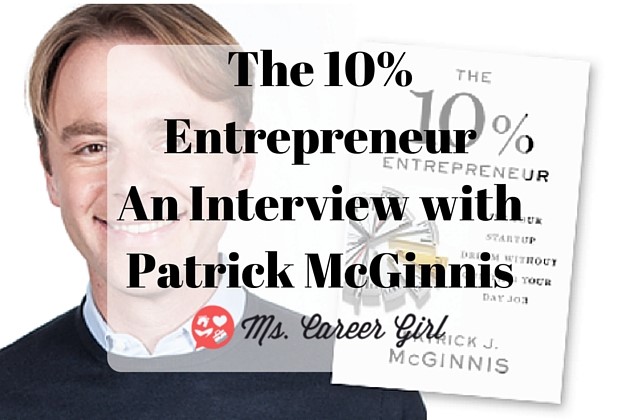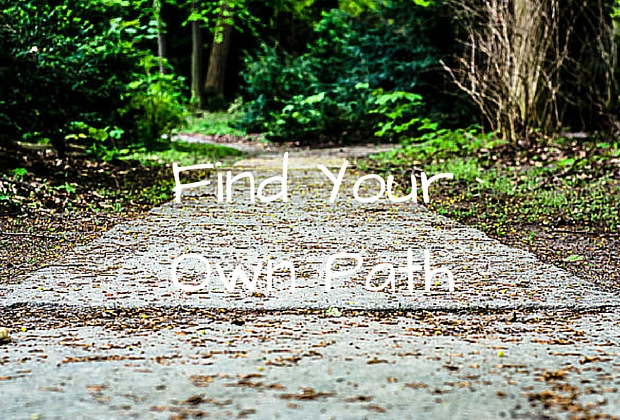The 10% Entrepreneur Patrick McGinnis

Every now and then, a book comes along that is so on-target, timeless and timely in one, that it is destined to spend a very long time on your bookshelf. The 10% Entrepreneur, by Patrick McGinnis, is one of those books. Neither Ms Career Girl nor the author have been compensated for this article. We highly recommend the book on its own merits.
As a successful 10% entrepreneur himself (“I definitely eat my own cooking”) Patrick lays out a detailed blueprint to take virtually anyone from someone with an idea through all the steps required to build themselves a truly entrepreneurial life. A venture capitalist and private equity investor who founded Dirigo Advisors and witnessed the AIG collapse from the inside, he is the quintessential example of a survivor.
Find Your Own Path
I had the opportunity to chat with Patrick in March, to get some additional insights, knowing that even the best of literary efforts don’t tell all. The one-line take away that we can all post on our wall: “Find your own path.” Here are some more of my favorite responses:
The 10% Entrepreneur
Q: We all have what I call defining moments, points of choice in our lives when the path is chosen, we and our life is forever changed. What was yours?
Patrick: Having lived through the implosion of a trillion dollar business, I realized I had to become much more self reliant than I had in the past. That I needed to find a way to diversify my career, and that’s when I decided that maybe entrepreneurship, in a way that works for me customizing to my life, is the way to do that. A lot of people that I know are still reeling from the crash. Even though we’re eight years on, I still have friends that haven’t found their way back yet. Because I think that we are, especially when you go through certain educational institutions or you work in certain firms, you really close your minds to things that are outside of that and you sort of get used to your conditions and start thinking of your success as a certain path, when actually there are many ways, and you overlook what may be an even better path for you.
Q: What part of The 10% Entrepreneur did you find most difficult to write?
Patrick: Figuring out how to take the lessons that I had learned but make them applicable to all kinds of different people, that was my biggest challenge. I wanted people of all different backgrounds, whether you’re a woman or a man, live in the United States or overseas, whether you’re working in the corporate environment or you’re a doctor or you’re a car salesperson, I wanted people to be able to relate to the stories in the book, and find at least one person who they thought was like them. So, that was my biggest challenge, I interviewed tons of people and tried to learn as much as I could from them and then bring it all together into a set of recommendations and exercises and suggestions that anybody could feel comfortable with.
Q. How do you suggest someone first narrow the focus and second let go of the need to get just one more expert opinion?
Patrick: That’s a great question. One of the things that I have learned is that the only way to actually learn how to be an entrepreneur is to actually do it. And so what I encourage people to do . . . is you just need to do something, even if it’s just very, very small. Go to that networking event, approach that entrepreneur you respect, spend a little time finding (out about) the industry you’re excited about, and get started in a little way, because what happens is that you gain a little confidence and you realize that it’s not as hard as you might think . . . I believe it doing it the right way, bit by bit. Anything you do the right way, and I learned this from my parents growing up, there’s no easy ways to win, there’s no cutting corners, you do it the right way, and you’ll have a far higher chance of success.
Q. I’m reminded of how Subway Restaurant began versus how regulated and bureaucratic our world is today. With that in mind, what advice would you give to a new entrepreneur?
Patrick: Depending on what industry you’re in, you may face challenges in healthcare, and hiring, that are government regulated. At the same time, there are so many things that used to be like nearly impossible for individuals to do themselves, that are now very easy to do. So for example, setting up a website used to cost tens of thousands of dollars, and it’s basically free now. When I started my career, one gigabyte of storage was $8,000, now it’s basically free. You can set up your website, you can set up your email, you can set up all the social media tools for almost nothing . . . it’s kind of astounding how you can run a business out of your living room. I understand that there’s concerns about regulation, but for many of us before we get to that point where we have to worry about those things, the initial start up costs are much, much lower than they have been in the past.
Q: A young career person is standing before you. You have 30 seconds to change the persons life. What would you say?
Patrick: I would say take time to build real skills, but never be afraid to find a way to do something that really plays to your own strengths. Don’t just follow your friends or the other people you went to school with. Find your own path.
————–
Neither Ms Career Girl nor the author have been compensated for this article. We highly recommend the book on it’s own merits.


